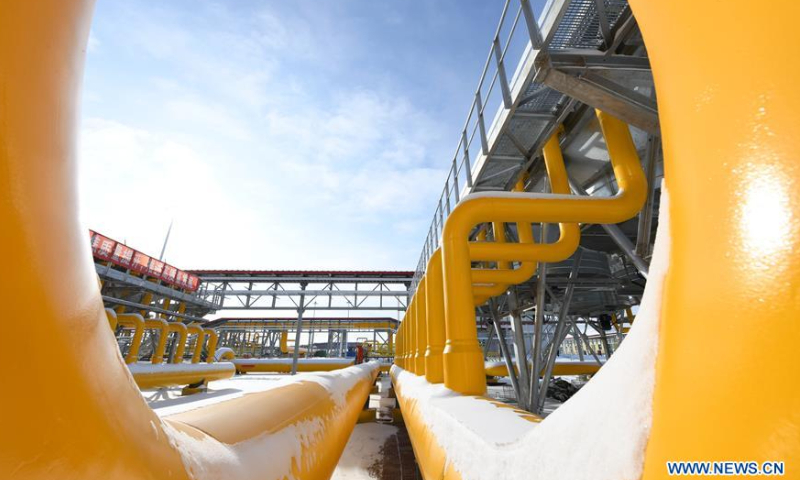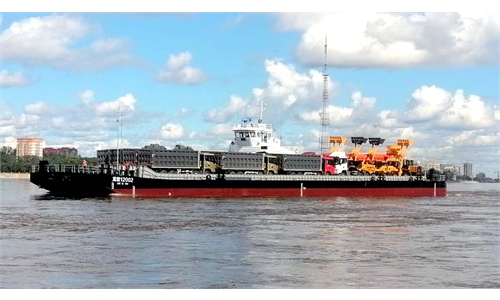
The photo taken on November 19, 2019 shows the gas-distributing and compressing station of the China-Russia east-route natural gas pipeline in the city of Heihe, the first stop after the Russia-supplied natural gas enters China, Northeast China's Heilongjiang Province. Photo: Xinhua
A section of the China-Russia east-route natural gas pipeline linking Anping, North China's Hebei Province with Taian, East China's Shandong Province, has been put into operation, with a designed capacity of 18.9 billion cubic meters a year, China Oil & Gas Pipeline Network Corporation (PipeChina) announced on Friday.
It marks further improvement of the energy channel in eastern China, the company said.
The Anping-Taian section is an important part of the southern section of the China-Russia east-route natural gas pipeline. The total length of the line is 320 kilometers, with a pipe diameter of 1,219 mm and a design pressure of 10 megapascals (MPa). Construction of the section started in October 2020.
"During the construction period, we overcame difficulties such as complex construction in the mountains, frequent floods and repeated epidemic outbreaks," said Zhang Tiancheng, a project manager at PipeChina, adding that technologies such as automatic welding have been widely adopted to improve efficiency.
After the whole line is put into operation, it will fully open up the energy channel in eastern China and promote the upgrading of the industrial structure and high-quality economic development in the areas along the pipeline, said Zhang. It is also of great significance for building a clean, low-carbon, safe and efficient energy system, Zhang noted.
The full China-Russia east route is a pipeline system spanning more than 8,000 kilometers, with a 3,000-km section in Russia and a 5,111-km stretch in China. It transmits natural gas from Siberia to nine provincial-level regions in China, according to a report from the Xinhua News Agency.
It has been divided into three sections: the northern section from Heilongjiang's Heihe to Changling in Northeast China's Jilin Province; the middle section from Changling to Yongqing in North China's Hebei Province; and the southern section from Yongqing to East China's Shanghai.
The northern section was put into use in 2019 and the middle section in 2020. The southern section is under construction and is expected to be completed and put into operation in 2025.
Russian gas exports to China via the pipeline have continued to increase in volume, and in the first six months of this year, they were up by 63.4 percent, Sputnik reported on July 15, citing data from Russian gas giant Gazprom.
From 2024, the pipeline is expected to provide China with 38 billion cubic meters of Russian gas annually, under a 30-year contract worth $400 billion signed between China National Petroleum Corp (CNPC) and Gazprom in May 2014, Xinhua said.
China is the world's largest importer of natural gas. About half of all China's natural gas consumption is imported and about two-thirds of imported gas enters in the form of LNG.
As the shift from coal to gas continues and the nation aggressively pursues carbon neutrality, China's natural gas consumption in 2021 increased by 19.9 percent to 121.36 million tons. In value terms, natural gas imports reached 360 billion yuan ($53.4 billion) in 2021, up 56.3 percent from 2020.
On the sidelines of the Shanghai Cooperation Organization in Samarkand, Uzbekistan on Thursday, leaders of China, Russia and Mongolia agreed to actively push the construction of the Mongolian section of the China-Russia natural gas pipeline.
Media reports said that construction of the Russian-Chinese natural gas pipeline transiting through Mongolia will begin in 2024. The pipeline will deliver previously Europe-bound gas from western Siberian fields to China for the first time and has a target date of being online in 2030.

